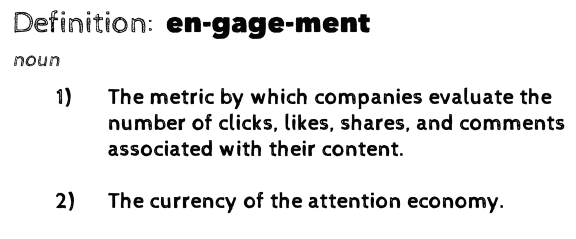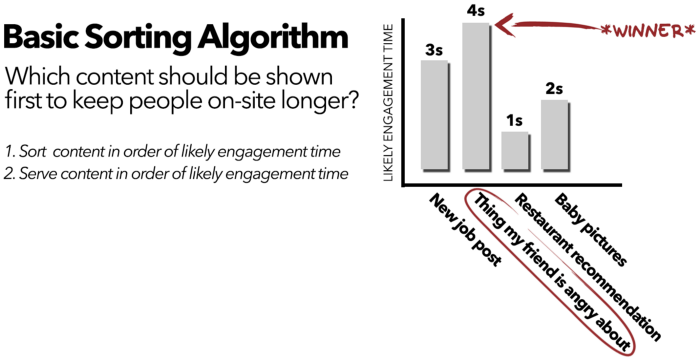
“Attention is a resource—a person has only so much of it” (Crawford 11).
“How do you focus your attention? How do you protect it? How do you apply it productively and strategically, and avoid giving it to bad actors or dubious sources? And how do you do that in a world where decisions about what to engage with are made in seconds, not minutes or hours?” (Caulfield)
Overview
In a world where information is abundant, where we are overloaded and overwhelmed with information on a daily basis, attention is the scarcity (Caulfield).
Algorithms are being used by social media platforms and news organizations to keep our attention focused on their websites. These and other digital platforms have discovered that the best way to keep us engaged with their websites is to promote sensational, divisive, or outrage-inducing content. Emotional responses are what keep us clicking, liking, commenting, and sharing—when trying to capture attention, our anger, fear and disgust are a signal in the noise. “People tend to react more to inputs that land low on the brainstem. Fear and anger produce a lot more engagement and sharing than joy. The result is that the algorithms favor sensational content over substance” (McNamee).
“Engagement”
“Many of the biggest problems we face in this moment as a society result from decisions being made by the hidden creators of our digital world—the designers, developers, and editors that create and curate the media we consume….They do this by focusing on one over-simplified metric, one that supports advertising as its primary source of revenue. This metric is called engagement, and emphasizing it—above all else—has subtly and steadily changed the way we look at the news, our politics, and each other” (Rose-Stockwell, “This Is How Your Fear and Outrage Are Being Sold for Profit”).

Tobias Rose-Stockwell, a writer and technologist focused on ethical design, explains how emotional reactions are strong indicators of engagement, and how divisive content that captures our attention will be shown in our feeds first. We then share our moral judgments with our own followers, creating what he calls “outrage cascades” that dominate our conversations online.


Indeed, in their report on “Information Disorder,” researchers Wardle and Derakhshan emphasize that: “Social networks are driven by the sharing of emotional content. The architecture of these sites is designed such that every time a user posts content—and it is liked, commented upon or shared further— their brain releases a tiny hit of dopamine (13).
The most notable example of this idea? Most of our content feeds and timelines are no longer sorted chronologically or by relevance. Instead, the decision about which content to show us is instead based on how likely we are to engage with it.


Sources
Caulfield, Mike. “Attention Is the Scarcity.” Hapgood, 4 Feb. 2019.
Crawford, Matthew. The World Beyond Your Head: On Becoming an Individual in an Age of Distraction. Farrar, Straus, and Giroux, 2016.
Graphics: “This Will Make You Cry,” “Engagement” definitions, “Chronological vs. Engagement Feed,” “Basic Sorting Algorithm” by Tobias Rose-Stockwell are licensed under CC BY-NC 4.0
Image: “Boy Mobile Phone” by Andi_Graf on Pixabay
McNamee, Roger. “How to Fix Facebook – Before It Fixes Us.” Washington Monthly, Jan/Feb/Mar. 2018.
Rose-Stockwell, Tobias. “How to Design Better Social Media.” Medium, 13 Apr. 2018. Licensed under CC BY-NC 4.0
Rose-Stockwell, Tobias. “This Is How Your Fear and Outrage Are Being Sold for Profit.” Medium, 14 July 2017. Licensed under CC BY-NC 4.0.
Wardle, Claire, and Hossein Derakhshan. “Information Disorder: Toward an Interdisciplinary Framework for Research and Policy Making.” Council of Europe, 27 Sept. 2017.
